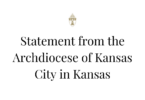
by Joe Bollig
joe.bollig@theleaven.org
EUDORA — The president was Abraham Lincoln and Americans were dying in a brutal civil war when the first Mass was celebrated at Holy Family Church here in 1864.
But the tides of history washed around — rather than over — the old, sandstone church, leaving it a rare Kansas survivor of that turbulent era.
On Oct. 14, the Archdiocese of Kansas City in Kansas received recognition of the historic nature of the church in a letter from the State Historic Preservation Office: “We are pleased to inform you that the Holy Family Catholic Church was listed in the National Register of Historic Places on Oct. 2, 2020.”
Parishioners Janet S. Campbell, Mark Schieferecke and Peter Bock led the effort to get the church on the registry.
“I grew up right across the street from the church,” said Campbell. “It’s always been a part of my life.”

Campbell remembers attending the old, wood-frame parish school (now gone) and attending Mass in the little stone church. When the new school and church were built in 1963, the old church was boarded up and largely neglected for the next 20 years.
In 1981, a group of townspeople — Catholic and non-Catholic alike — decided to form a committee to repair and maintain the church. Today, the church is used for Saturday evening vigil Masses, eucharistic adoration, private prayer, community Christmas concerts and occasional weddings and funerals.
The effort to get the old church on the historic register began in the parish council.
“It was in 2017, and I was on the parish council,” said Campbell. “We had finished the parish’s 150th anniversary and it’s the oldest Catholic church in Kansas still in use. I’m a bit of a history buff, and the council decided it would be good to get the church some recognition.”
What followed was a period of research, report writing and correspondence until the recognition was granted.
Holy Family Church was built in 1864 from sandstone quarried east of Eudora and mortar made from sand from the Kansas River. Parishioners dressed the stone with custom-made chisels that left distinctive marks on the stone. The building has 18 Gothic Revival style arched windows.
The building became L-shaped with the addition of a one-room sacristy in 1891 and a vestibule and tower in 1896. Electricity was installed possibly as early as 1916, and parishioner Frank Sommer (Campbell’s grandfather) built the current altar in 1926. Stained- glass windows were added in 1942. The plastered interior (rumored to have murals) was covered with fiberboard panels in 1946. The church lost its pointed steeple sometime in the 1950s — it is unclear whether the cause was by storm damage or deterioration.

The church has a bell again that can be pulled by a rope, thanks to a flea market find by Campbell. The original two bells were hung in the 1963 church/school building.
According to the application, “the building remains in excellent condition and retains significant historic integrity . . . [and] completely retains its original exterior and interior appearance,” and the historic alterations contribute to the building’s “overall character-defining features.”
Ongoing maintenance is a perpetual challenge, said Peter Bock, chairman of the parish building and grounds committee. Just this summer, volunteers replaced louvers and deteriorated wood in the steeple.
“The challenge of the old church is that we’ve had a very little, if any, budget,” said Bock. “It’s been volunteer donations and sweat equity.”
Having a listing on the register qualifies the old church for Kansas Rehabilitation Tax Credit and the Heritage Trust Fund grant program.
“Hopefully, we’ll be able to apply for some grants [for] some more renovations,” said Bock. “There’s been a lot of deferred maintenance. Renovations could be done with grants or other financial assistance in the form of partial tax credits. A nonprofit [like the church] can sell the tax credits.”






